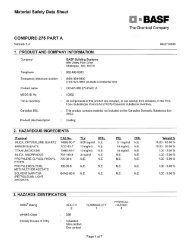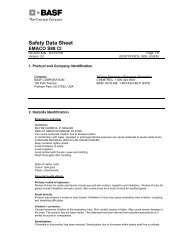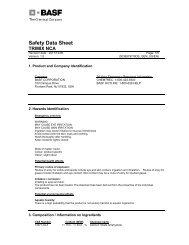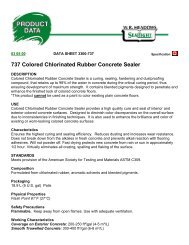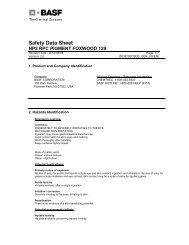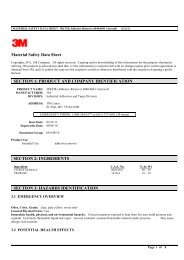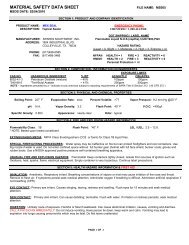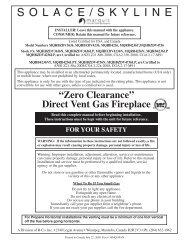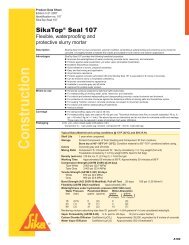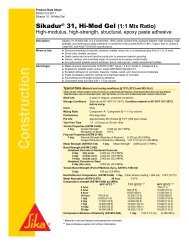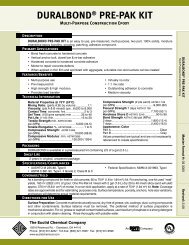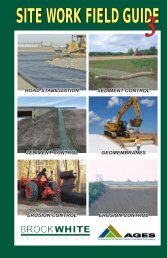You also want an ePaper? Increase the reach of your titles
YUMPU automatically turns print PDFs into web optimized ePapers that Google loves.
General and TechnicalInformationGeneral andTechnical InformationDayton Superior’s Role in the Development of Tilt-UpSince the beginning of tilt-up construction, Dayton Superior has been instrumental in developing and manufacturing thehardware necessary to safely and economy in the most critical steps for this method of construction -- that of lifting the wallpanel and placing it in place without damage. The embedded coil insert pioneered by Dayton Superior was an importantdevelopment in tilt-up techniques. A major breakthrough resulted in the mid-sixties with the design of the Twist-Lift insert andlifting hardware. The Twist-Lift System was one of the simplest and most economical lifting systems on the market for manyyears. The Twist-Lift System was a quick connect-release system and was the forerunner of today’s ground release systemsFurther innovations have been made through research and development of the Ground Release Swift Lift System for tilt-upconstruction. This system offer tilt-up contractors the advantage of being able to release of the lifting hardware from theground with a simple pull on a release line. Worker safety was greatly improved as the Ground Release Swift Lift Systemeliminated the need for workers to climb a ladder to remove the lifting hardware from the panel.Dayton Superior has continued to strive to provide the contractor with a variety of options for lifting panels, developingthe Gyro Tilt Plus System, the Tilt-Up 3 Lifting System and recently introduced the Superior Lift Tilt-Up System. Our productdevelopment team continues to strive to provide a complete package for economical and safe construction of tilt-up buildings.Technical ServicesDayton Superior maintains two strategically located Technical Services Department, located in Ohio and California. DaytonSuperior Technical service is based on approximately 50 years experience involved in detailing several million panels of allshapes, sizes and degree of difficulty. Using computer aided design, the following services are provided to serve the needs ofthe Tilt-Up Construction Industry. Services include:• Consultation/recommendations• Panel erection details• Wind bracing requirements• Additional reinforcement, if necessary• Strongback requirements, if necessary• Rigging methods• Material takeoffsGeneral Tilt-Up ConsiderationsTilt-up construction involves the following considerations:• The tilt-up concrete panel is partially supported by the ground or slab during tilting.• The concrete panel is usually handled only once.• After tilting, the panel is only raised two to three feet and is generally not moved very far by the crane.At the time of initial lift, the face lift inserts and bolts/hardware are in tension or in a combination of tension and shear. As thepanel is rotated and raised, tension decreases and shear increases as the entire load is transferred to the inserts (when thepanel is in a vertical position).Tilt-up panels must be reinforced with no less than the minimum steel required by the latest edition of the AmericanConcrete Institute, Building Code Requirements for Reinforced Concrete (ACI 318). As a general rule, #4 bars at 12” O.C. inboth directions will satisfy the requirement. If flexural stress limits will be exceeded during lifting, additional reinforcing steel, orstrongbacks must be added to the panel.DefinitionsRated Load — The maximum load that should be applied to an anchor, insert, coil bolt, brace or lifting hardwareunit. Safe Working Load, Safe Load Carrying Capacity or SWL are other terms used in thishandbook for the term Rated Load.Ultimate Load — The average load or force at which the item fails or no longer will support or carry a load.Dynamic Load — A resulting load from the rapid change of movement, such as the sudden stopping, jerking orimpacting a static load. A dynamic load may be several times a static load.Safety Factor — A term denoting theoretical reserve capability which has been determined by dividing the ultimateload of the product by its rated load. This is expressed as a ratio; for example, 2 to 1.4 02-09



